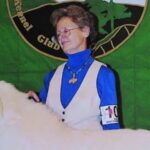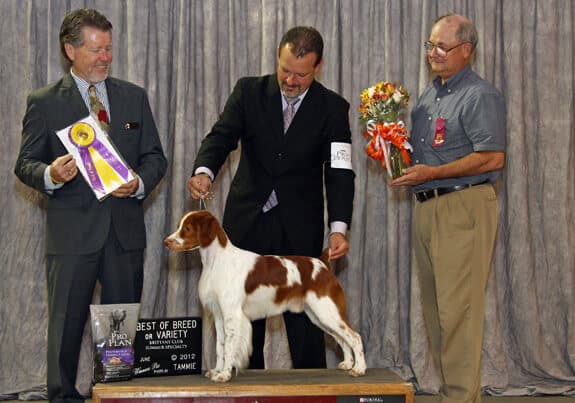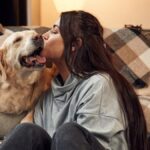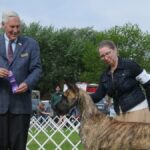Interview with a Sporting Group Judge Dr. Steven Herman.
1. Where do you live? How many years in dogs? How many years as a judge?
2. What is your original breed? What is/was your kennel name?
3. Can you list a few of the notable dogs you’ve bred? Any performance or field titles?
4. How important are Performance and Companion titles in a Sporting Dog?
5. Have you judged any Sporting Breed Specialties?
6. Do you find that size, proportion, and substance are correct in most Sporting breeds?
7. Is breed-specific expression important to you as a judge? Can you offer some examples?
8. What are your thoughts on the current grooming practices among the coated breeds?
9. Are the Sporting breeds in good shape overall? Any concerns?
10. In your opinion, how do today’s exhibits compare with the Sporting Dogs of the past?
11. Why do you think the Sporting breeds make up a large portion of the typical show’s entries?
12. Just for laughs, do you have a funny story you can share about judging the Sporting Group?
Sporting Group Judge Dr. Steven Herman
The sign in my office reads: “Full-Time Dog Man, Part-Time Attorney.”
I started “in dogs” in 1980, just a couple of years after beginning my practice. Picking my first German Shorthaired Pointer puppy, at ten weeks of age, I did a pretty good job. “Rommel” was a Top Ten dog, along with being my versatile dog, doing Obedience and NAVHDA. I have remained active and successful in this breed. My bitch was Best of Breed at Westminster in 2010 and she went on to be the top-producing dam for 2011. Her son garnered my first All-Breed Best in Show, in 2013, with a German Shorthaired Pointer. He was top-producing sire for 2013, 2014 and 2015 and now has over fifty champion get.
With my first wife, I exhibited Afghan Hounds for many years. Then I did some showing and breeding of English Cocker Spaniels and Golden Retrievers. However, my next big venture was with Pointers. Since 1990, I have been involved with this breed, owning and breeding many Group and Best in Show winners. Most have had their hunting titles, too. One Best in Show bitch also was the Top Field Trial Puppy.
Acquiring a German Wirehaired Pointer bitch in 1995, I campaigned her to the Top Ten. A bitch from her litter was shown by me to the Top Ten—three years in a row. During this time, I also owned a Miniature Wirehaired Dachshund. My current Wirehair has been in the Top Ten the past two years. He won the National and concurrent Regional Specialties in 2019. He is a multiple Group winner.
My experience with the three Pointer breeds led me to present a comparison seminar about them. I now judge the Sporting and Hound Groups and Best in Show. I have officiated at the German Shorthaired and Wirehaired Pointer Nationals, the Pointer Club of Canada, and the Golden Retriever National. My wife and I live with, show, and hunt a GSP and a GWP in Wesley Chapel, Florida. I co-own a number of other GSPs that allow me to remain active in conformation, breeding, hunt tests, and field trials. We collect dog art and travel to Crufts regularly. I have judged in Colombia, Canada, China, and Sweden.
Where do I live? How many years in dogs? How many years as a judge? I live on Quail Hollow Boulevard (apt name for a bird dog residence!) in Wesley Chapel, Florida. I’ve been involved in AKC events since 1980 when I acquired my first dog, a German Shorthaired Pointer. I began judging in 1995.
What is my original breed? What is/was my kennel name? My dog’s name was CH Herr Rommel Von Insel CD NAVHDA Prize One. He was a Top Ten dog, piloted by Wendy Wolforth, and a multiple Group winner. I chose to honor him by selecting Von Rommelhaus as my kennel name. I use it for my German Wirehaired Pointers too. My ex-wife and I used Sunset for the Pointers, English Cockers, and Goldens. My Pointers now carry the Wesley Chapel name.
Can I list a few of the notable dogs I’ve bred? Any performance or field titles? “Rommel” sired CH Buchwood’s Desert Fox. She was shown by myself and Davin McAteer to multiple Group wins and a Top Ten ranking. I acquired CH Von Insel Twilight’s Last Gleam and she was the foundation of what I have today. She won many Groups and Specialty shows, was ranked in the Top Ten, and most importantly, produced very well. “Twilight” was the GSPCA’s Top Producing Dam as a result of her first litter. One of her get was CH Rijaro’s Windswept Fantasy, which I owned with Lynn Rhodes, her co-breeder. Shown by Charlie and Laura Coombs and Lynn’s daughter, Tracy, she won BOB at Westminster, the National Top Twenty, and multiple Groups, and was a Top Ten ranked dog. Her son, “Grant,” was my first Best in Show Shorthair, a multiple Group and Specialty winner, and the top-producing sire in the breed for three consecutive years. He has sired more than fifty champions at last count.
My first Pointer was CH Solivia’s Sky High, a multiple Group winner and Top Ten ranked. In collaboration with Marjetta Kennel, my ex-wife and I bred the Moon litter. Most well-known was CH Marjetta’s Dark Side of the Moon JH, a multiple Best in Show bitch shown by Marjorie Martorella. She was Field Trial Puppy of the Year. Her sister, CH Sunset’s Harvest Moon JH, and brother, CH Marjetta’s Bad Moon on the Rise, were also both Group winners.
The first German Wirehaired Pointer I obtained produced CH Mariad’s Raven Mad Von Rommelhaus. She was in the Top Ten three years in a row and was a multiple Group winner, shown by myself. Currently in residence is GCHB Reece Ripsnorter Return of the King. He won the 2018 National and Regional Specialties, and multiple Groups, and was ranked number one or two male the two years he was shown.
I have bred one Senior Hunter and many Junior Hunters. I have recently returned to the Hunt Test field with my young Grant daughter. She won her JH in two weekends and I am looking forward to a Senior title.
How important are Performance and Companion titles in a Sporting Dog? Performance and Companion titles are very important for Sporting Dogs. They are the tests that confirm the standard’s temperament requirements. One club makes this very clear. Nova Scotia Duck Tolling Retrievers are bred to toll, lure, and retrieve. The standard encourages all owners to pass a NSDTRC Field Test to ensure the dogs are able. In Goldens, to have the character and quality to win in the show ring, a judge should consider whether they could function as a retrieving gun dog to hunt waterfowl or upland game. Vizsla breeders and owners should strive to maintain a “dual dog” according to that breed’s standard. One can’t do this without performance testing to foster and appreciate a good-nosed, natural hunter. Most of the Sporting Dog standards call for participation in many activities. You can’t know whether a Lagotto has a gift for searching (even if it’s not truffles!) and not being distracted by game if you don’t do scent work. Whether or not a Griffon can naturally point and retrieve can’t be seen in the Conformation ring. Pointers, GSPs, Chesapeake Bay and Flat-Coated Retrievers, Boykins, Cockers, English Cockers, and Springer Spaniels all have specific discussions about the proper dog having traits that you can only test in the field or on the hunt.
Have I judged any Sporting Breed Specialties? I have judged at the major specialties set out in my bio. I have also adjudicated many specialties held in conjunction with nationals and others.
Do I find that size, proportion, and substance are correct in most Sporting breeds? While substance is not often a concern in Sporting breeds, proportion issues are seen very many times. It is usually what takes a dog out of contention in my ring. Breeders appear to be ignoring the standards when having litters and selecting dogs with long backs and loins, perhaps for the “tremendous reach and drive,” but neglecting the standards—even those calling for a short back. Also, breeding and showing rectangular dogs when they are supposed to be square. Numerical proportions are also ignored. Slightly longer than tall is extended out. And although some dogs will present as possibly over or undersized, it is not often that this warrants wicketing.
Is breed-specific expression important to me as a judge? Can I offer some examples? Expression can be very important. In Spinones, it is “paramount” to that breed. In English Cockers, proper head parts combine to produce the expression distinctive of the breed. Wirehaired Vizslas and Griffons must have appropriate eyebrows, beards, and eye shape for correct expression. In Sussex Spaniels, it’s an important feature. And lacking the required eye color creates a harsh expression in a Lab, which is undesirable.
What are my thoughts on the current grooming practices among the coated breeds? Grooming practices are best done by following the standards. If you use the proper trim on a Lagotto it will be unpretentious and will contribute to the correct look typical of the breed. If you do extreme or excessive grooming on GWPs or Flat Coats, you should be severely penalized. The best rule to follow is not to alter a breed’s natural appearance. In Irish Setters you are encouraged to trim to do just that. In many Spaniels it is important to look as natural as possible.
Are the Sporting breeds in good shape overall? Any concerns? All of the Sporting breeds could be improved. Isn’t that what we are striving for? There are wonderful specimens in each breed, but many more that could be improved.
In my opinion, how do today’s exhibits compare with the Sporting Dogs of the past? I look at old photographs quite often. I believe what was winning in those years would not be competitive today. There were lovely dogs [in the past] too, but no more than the greats of today.
Why do I think the Sporting breeds make up a large portion of the typical show’s entries? Sporting Dogs are a large portion of entries. Why? They are the Boy Scouts of Animals: Trustworthy, Loyal, Friendly, Obedient, and Cheerful. All descriptions from the standards! Add that they are affectionate, intelligent, have a willingness to please, are gentle-mannered, sociable, patient, stable, have a sense of humor, sensitive, fun-loving, merry, faithful, playful, and loving. How can you go wrong? And if you want company at the pub, get a “rollicking” Irish Setter!
Sporting Dogs are a large portion of entries. Why? They are the Boy Scouts of Animals: Trustworthy, Loyal, Friendly, Obedient, and Cheerful.
Just for laughs, do I have a funny story I can share about judging the Sporting Group? A specific funny story doesn’t come to mind. However, it is not uncommon for most to have a laugh, smile, or have a good time in my ring. Just ask around. I strive to make everyone’s experience a fun one.









